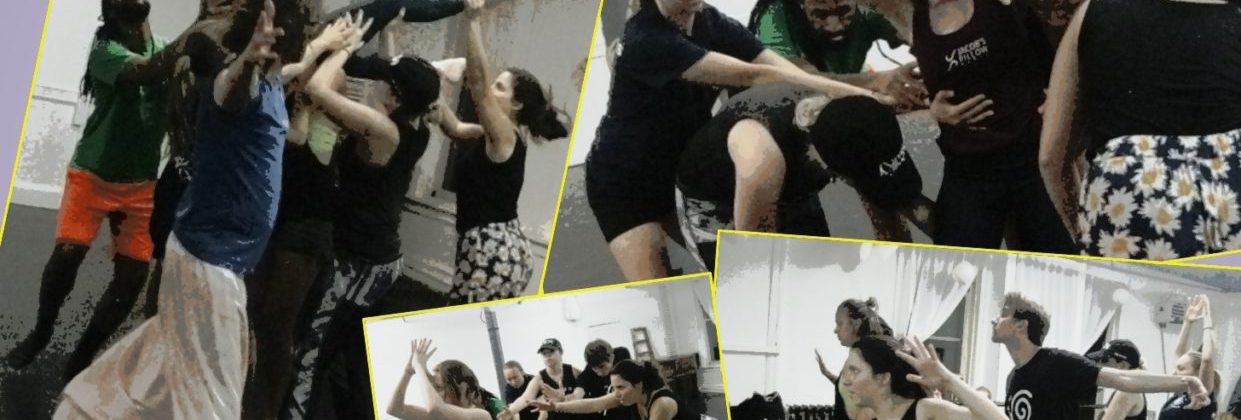Paradise Moves tells stories without words
This is not dancing.
It’s understandable if you’re confused. We’re in a dance studio, after all—barres, mirrored wall, rubbery floor, signs reminding us that street shoes aren’t allowed.
There’s music, and people are moving. Over the course of 90 minutes, bodies flow through the room in endless ways—walking, leaping, skipping, jumping, crawling, spinning, rolling, slinking, dragging, carrying.
Spines bend in every direction.
Limbs expand to fill space, then contract to empty it. It looks like dancing, and you might recognize elements from dance—pointed toes here, an arabesque there—but this is not dancing.
This is movement.
What’s the difference?
“Movement is the pure form of performance and expression,” says Tyler Catanella, the artistic director of Paradise Moves. “Dance implies technique, and it implies knowledge and understanding of how to do it. There are so many people that say, ‘I don’t dance,’ and I think that’s because what’s projected in dance is technical training. That’s important for the form, but it’s not the most important thing. What’s most important is the storytelling.”
Paradise Moves is an ensemble that tells stories without words. Enough, an original piece about identity and mental health, premiered last year at the Arsenal Center for the Arts, and the group also organizes the annual More than Moves festival to raise money for Transition House, an agency that supports survivors of domestic violence.
The Movement SLAMS are another arm of Paradise Moves, open to anyone who wants to practice telling a story through movement. Unlike the competitive poetry and story slams most people associate with the word, in this case SLAM is an acronym, standing for Storytelling, Listening and Movement.
Catanella began developing the SLAM format about 10 years ago, as an undergrad at Emerson College. What began as a space for friends to loosen up and have fun moving creatively has evolved into twice-monthly workshops open to the public.
At the start of every SLAM, people share why they’re there: An actor wants to experiment with a new character. Someone else wants to warm up for a flag football game later that afternoon.
People say they’ve come to shake off a bad week, to have fun, for a workout, to connect with others, or simply to move freely. There are often new faces who say they have no idea what to expect, but they saw the event on Facebook and want to try something new.
No dance experience is required. In fact, some dancers find the SLAM difficult at first. Andrea West, Paradise Move’s SLAM coordinator who found the group after many years of dance training, says, “I’ve always been comfortable dancing, but it took me a while to be comfortable moving, not having it be perfect, not having steps or choreography.”
The movement begins with simple warmups, stretching and shaking to wake muscles, then just walking around the room. The Paradise Moves ensemble member leading the SLAM calls out directions —walk, change directions, freeze, start walking again.
From there, it progresses to simple games that take people out of their heads. One week we’re asked to move as colors: How does the color green move across a room? How about red?
Another week, there was a game that mixed the classic games of Charades and Telephone, with one person acting out a phrase and another interpreting it so that one person’s “I’m so happy I could die” becomes someone else’s “The rain will give you dysentery.”
The second half of every SLAM is devoted to the Circle SLAM, an improvised half-hour of movement that usually, by the end, becomes a story. There’s music, sometimes with SLAM participants contributing to the playlist. One may enter and exit the performance circle as they wish, but no one can be pulled in.
It’s a place to connect and have conversations through movement, in the moment. As people enter and exit the circle, relationships and themes emerge. Simple gestures like pointing or waving at each other evolve and change meaning. Two people chase and catch each other, celebrate, move apart again.
Another pair appear to fight, then a few songs later they walk calmly towards each other in chaos and hold hands in a moment of apology.
Sometimes people carry each other on their backs.
Some just watch from the edges.
I went to several SLAMS while writing this article, each time trying to find the right words to describe an experience that is deliberately without words. I walked, ran, spun furiously, held poses, pretended to be a mouse as I scrambled on the floor.
I went to one SLAM with troubles on my mind and acted out the argument I could not actually have, and afterwards I felt exhausted, the feelings compressed into a smooth pebble—not disappeared, but smaller and easier to examine. Another week I pretended to carry lit candles in tandem with a stranger, moving solemnly across the room in honor of something undefined, and felt peaceful.
Each time I left the studio after a SLAM I was sweaty and breathless, but energized and happy.
This is not dancing, but it feels like it.




